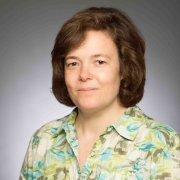Jane Willenbring Discovers Earlier Peak for Spain's Glaciers

It has been thought that the last ice age peaked about 20,000 years ago, but geologist Jane Willenbring and her team have discovered that glaciers actually reached their maximum extension around 6,000 years earlier, at least in southern Europe. The findings shed new light on how regional climate has varied over time and could lead to more-accurate global climate models, which predict what changes Earth will experience in the future.
Willenbring, an assistant professor in the Department of Earth and Environmental Science, teamed with researchers from Spain, the United Kingdom, China, and the United States to pursue this study of the sheets of ice that once covered southern Europe. They reported their findings in the journal Scientific Reports.
In the study site in central Spain, it is relatively straightforward to discern the size of the ancient glaciers. Because the ice carried and dropped boulders at its margin, a ring of stones marks the edge of the glacier. It is not as easy to determine what caused the glacier to grow, however. Glaciers need both moisture and cold temperatures to expand, and caves provide a way to differentiate the two factors. Stalagmites and stalactites carry a record of precipitation because they grow as a result of dripping water.
“If you add the cave data to the data from the glaciers, it gives you a neat way of figuring out whether it was cold temperatures or higher precipitation that drove the glacier growth at the time,” Willenbring said.
The researchers conducted the study in three of Spain’s mountain ranges: the Bejár, Gredos and Guadarrama. The nearby Eagle Cave allowed them to obtain indirect precipitation data. They found that, although temperatures were cool in the range of 19,000-23,000 years ago, conditions were also relatively dry, so the glaciers did not regain the size they had obtained several thousand years earlier, when rain and snowfall totals were higher.
Given the revised timeline in this region, Willenbring and colleagues determined that the increased precipitation resulted from changes in the intensity of the sun’s radiation on the Earth, which is based on the planet’s tilt in orbit. Such changes can impact weather patterns.
When glaciers were peaking in the Mediterranean around 26,000 years ago, the American Southwest was experiencing similar conditions. Areas that are now desert were moist. Large lakes abounded, including Lake Bonneville, which covered much of modern-day Utah. The state’s Great Salt Lake is what remains.
“Lakes in this area were really high for 5,000-10,000 years, and the cause for that has always been a mystery,” Willenbring said. “By looking at what was happening in the Mediterranean, we might eventually be able to say something about the conditions that led to these lakes in the Southwest, too.”
Read the full story here.





